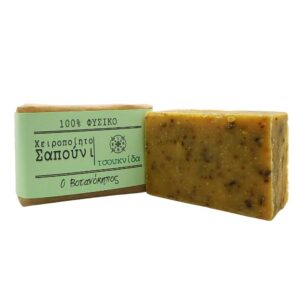PRODUCTS
ΣΑΠΟΥΝΙ – ΓΑΛΑ ΓΑΪΔΟΥΡΑΣ & ΜΕΝΤΑ
4,50 €
Σαπούνι Γάλα Γαϊδούρας
με βρώμη, μέλι και αιθέριο έλαιο μέντας
90 – 110 γρ / 100% φυσικό σαπούνι
Στη φόρμουλα του σαπουνιού εμπεριέχεται φρέσκο γάλα γαϊδούρας.
Το γάλα γαϊδούρας προσφέρει ισχυρή ενυδάτωση διατηρώντας την υγρασία του δέρματος.
Έχει αντιμικροβιακές ιδιότητες, ενώ βοηθά αποτελεσματικά στην ξηροδερμία και
σε άλλες δερματικές παθήσεις.
1 review for ΣΑΠΟΥΝΙ – ΓΑΛΑ ΓΑΪΔΟΥΡΑΣ & ΜΕΝΤΑ
Σαπούνι Γάλα Γαϊδούρας
με βρώμη, μέλι και αιθέριο έλαιο μέντας
90 – 110 γρ / 100% φυσικό σαπούνι
Στη φόρμουλα του σαπουνιού εμπεριέχεται φρέσκο γάλα γαϊδούρας.
Το γάλα γαϊδούρας προσφέρει ισχυρή ενυδάτωση διατηρώντας την υγρασία του δέρματος.
Έχει αντιμικροβιακές ιδιότητες, ενώ βοηθά αποτελεσματικά στην ξηροδερμία και
σε άλλες δερματικές παθήσεις.
| Weight | 0,100 kg |
|---|
HERBAL GARDEN
The soaps of the “Herbal Garden” workshop are made with extra virgin olive oil, castor oil and coconut oil.
Olive oil is loaded with Vitamin A and E, and with important metals like calcium, iron, zinc and with some organic compounds like polyphenols and squalane which ensure skin hydration and improve its elasticity.
Castor oil is a vegetable oil which is extracted from the seeds of the Ricinus communis plant. This plant is grown mainly in Africa, North America and India. Castor oil contains antioxidants that neutralize free radicals in the body. It also possesses antibacterial properties. It is used to enrich soaps with moisturizing and foaming properties.
Coconut oil is extremely high in saturated fat and it is produced traditionally by extracting the oil from raw coconut or from dried copra of coconut. In room temperature, it is in a solid form but when heated it softens or even melts. It has powerful hydrating properties, due to its abundance in Vitamin E, and thus nourishes and moistures both skin and hair. It has been also proved that coconut oil is effective for dry skin and for the treatment of mild dermatitis conditions. It speeds up the skin healing process while its antioxidants make it an important compound in products for skin care.
The soaps of our workshop are made by cold process. Furthermore, by choosing to superfat our soaps we boost the moisturizing properties.
The process of making handmade soap by cold saponification
Legend has it that in 1000 B.C., when women went to the Tiber River at the bottom of Mount Sapo, where animals were sacrificed, noticed that their garments were cleansed when they touched the sudsy mud which was dragged along with the river from the mountain. Soon, it occurred to them that the rain had washed down a mixture of wood ashes and grease from the sacrificed animals depositing it on the clay soil on the banks of the river and its basin which then released that cleansing foam.
The chemical reaction of an acid (oils) with an alkali base (typically sodium or ash water) forms fatty acid salts known as soaps. This process is named saponification. There are various alternative ways of soap making but most common in hand made soaps, is the so-called cold process.
In cold saponification, the neutralization of the sodium hydroxide (caustic soda) for the cure of the soap does not need an external source of heat. It is a long gradual process, about 4-6 weeks before the soap is ready for use. The non-use of heat guarantees the preservation of the properties of the essential oils added during the procedure.
More analytically, in the cold process, sodium hydroxide blended with water is gradually mixed with oil fats. Essential oils and natural dyes like clays are also added. The preparation is poured into large molds (slabs), where the saponification reaction needs about 24 hours to be completed. Crude soap is then removed from the molds and after a further 24 hours it is shaped into bars. At this stage, curing of the soap begins. For the next four to six weeks the soap is cured as the sodium hydroxide reacts with the carbon hydroxide of the atmosphere and the water evaporates gradually, leaving a soft and fixed soap bar.
In this process, a certain quantity of vegetable oils is also added (superfat) so as to provide hydrating properties to the soap since they retain their compositions.
Furthermore, during the cold process glycerin, which is a side product of the process, is preserved and no chemical that could affect the natural reactions is added. Since in this natural process nothing is removed from it and no chemical is added the final product is a natural soap.
Soda powder (sodium carbonate) on the surface of the soap: It is a white-ashen layer on the surface of the soap. It is formed when unsaponified sodium hydroxide reacts with naturally-occurring carbon dioxide in the air. It doesn't affect the quality and the safety of the soap, at all.
- Susan Miller Cavitch, Φτιάχνω μόνος μου σαπούνι, εκδ. Ψυχάλου, 2012
- Mary Humphrey & Alyssa Middleton, Advanced Soap Making, Beauty For Ashes Press, USA, 2019
- Alicia Grosso, The Everything Soapmaking Book, Adams Media, 3rd Edition, NY, 2013.
- Parker A., Natural Soap Making, USA, 2019.
ADDITIONAL INFORMATION
USE
INGREDIENTS
Sodium Olivate, Sodium Cocoate, Aqua, Lac Asinae (Donkey Milk), Sodium Castorate, Mentha Piperita Oil (Peppermint oil), Sodium Lactate, d-Limonene.







Ελένη Ροκά –
Το σαπούνι μυρίζει υπέροχα με το χαρακτηριστικό άρωμα της μέντας, που δημιουργεί αίσθηση φρεσκάδας! Επιπλέον, καθαρίζει απαλά το πρόσωπο με κρεμώδη αφρό και αφήνει την επιδερμίδα ενυδατωμένη και λαμπερή! Συστήνω ανεπιφύλακτα να το δοκιμάσετε.